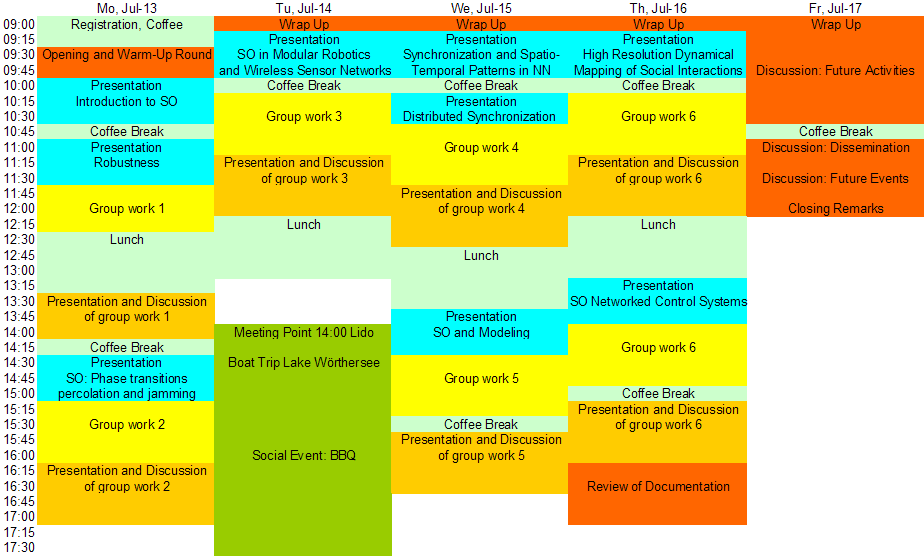Difference between revisions of "Lakeside Research Days'09"
(→Self-organizing Synchronization) |
(→Self-organizing Synchronization) |
||
| Line 72: | Line 72: | ||
===Self-organizing Synchronization=== | ===Self-organizing Synchronization=== | ||
C. Bettstetter and J. Klinglmayr | C. Bettstetter and J. Klinglmayr | ||
| + | |||
[http://mobile.uni-klu.ac.at/selforganized-wiki/images/3/3b/B-09-07-research-days.pdf Slides] | [http://mobile.uni-klu.ac.at/selforganized-wiki/images/3/3b/B-09-07-research-days.pdf Slides] | ||
Revision as of 09:33, 16 July 2009
Contents
- 1 Prolog
- 2 Research Days'09
- 3 Scheduled Talks
- 3.1 Introduction to Self-Organizing Systems
- 3.2 Robustness and Dependability
- 3.3 Self-Organization in Modular Robotics and Wireless Sensor Networks
- 3.4 High resolution dynamical mapping of social interactions with active RFID
- 3.5 Self-Organizing Networked Control Systems
- 3.6 Vortrag Passau
- 3.7 Self-organization: phase transitions, percolation and jamming
- 3.8 Synchronization and Spatio-Temporal Patterns in Neural Networks
- 3.9 Self-organizing Synchronization
Prolog
This meeting has been held on Friday, 19th of June 2009, 9AM - 1PM. The overall aim of this meeting was to collect ideas/problems which should be tackled during the Lakeside Research Days'09.
Participants: Christian Hofbauer (NES/ES), Alexander Onic (NES/ES), Markus Reichhartinger (SST/CM), Evsen Yanmaz (NES/MS), Johannes Klinglmayr (NES/MS), Istvan Fehervari (NES/MS), Kostyantyn Shchekotykhin (AINF/ISBI), Simon Triebenbacher (SST/AM), Markus Quaritsch (NES/PC), Helmut Adam (NES/MS), Laszlo Böszörmenyi (ITEC), Gerhard Friedrich (AINF/ISBI)
Research Days'09
The Lakeside Research Days 2009 take place as a five days workshop from July 13 to July 17, 2009.
Tentative workshop schedule:
Register to the workshop via doodle.
Scheduled Talks
Introduction to Self-Organizing Systems
F. Heylighen
Robustness and Dependability
W. Elmenreich
Self-Organization in Modular Robotics and Wireless Sensor Networks
A. van Rossum
Almende is a research company, based in Rotterdam, with a special focus on self-organization. In the form of a communication platform this is implemented as feedback of users of the system that subsequently reconfigures communication channels between them or service providers. A wireless sensor network takes this concept further in the form of a Kohonen network implemented on a wireless sensor nodes, that is able to cluster certain patterns which can be used for intruder detection or toilet management. At the end of the spectrum of self-organization lies modular robotics in which a Itti-Koch sensor fusion architecture is implemented, with an underlying evo-devo engine. Without human design changes in the topology are tested within such a developmental paradigm, so certain symmetries remain preserved across mutations. The developmental engine is a gene regulatory network as build by Bongard and the interactions between genes and their products is one of the most salient examples of self-organization at work. In engineering this type of non-linearities and dynamics is seen more and more as a tool, rather then a problem. There is however a real demand for thorough mathematical approaches similar to e.g. renormalization theory and applicable to real world problems and software.
High resolution dynamical mapping of social interactions with active RFID
A. Barrat, C. Cattuto, V. Colizza, J-F Pinton, W. van den Broeck, A. Vespignani
In this paper we present an experimental framework to gather data on face-to-face social interactions between individuals, with a high spatial and temporal resolution. We use active Radio Frequency Identification (RFID) devices that assess contacts with one another by exchanging low-power radio packets. When individuals wear the beacons as a badge, a persistent radio contact between the RFID devices can be used as a proxy for a social interaction between individuals. We present the results of recent pilot studies performed during conferences, and a subsequent preliminary data analysis, that provides an assessment of our method and highlights its versatility and applicability in many areas concerned with human dynamics.
Self-Organizing Networked Control Systems
C. Zschoppe
Vortrag Passau
H. de Meer
Self-organization: phase transitions, percolation and jamming
R. de Souza
Self-organization comes in many forms and seems to lack precise definition. Perhaps universal to all the phenomena is the formation of order from purely local interactions. Yet, local structures may also be influenced by global constraints. Here we review 1) a simple model of granular flow showing how the interplay of local and global constraints can delay the onset of jamming; and 2) limited pertubations that change the nature of the percolation transition in random networks. I will also attempt to discuss the robustness (or lack thereof) of these dynamical processes.
Synchronization and Spatio-Temporal Patterns in Neural Networks
M. Timme
Patterns of precisely timed and spatially distributed spikes have been experimentally observed in different neuronal systems. These spike patterns correlate with external stimuli and internal states and are thus considered key features of neural computation. Their dynamical origin, however, is unclear. One possible explanation for their occurrence is the existence of excitatorily coupled feed-forward structures, synfire chains, which are embedded in a network of otherwise random connectivity and receive a large number of random external inputs. We here show how precise spike timing and temporal locking can naturally arise in the nonlinear dynamics of recurrent neural networks that contain no additionally embedded feed-forward structures.
Self-organizing Synchronization
C. Bettstetter and J. Klinglmayr
